Root Rot Management in Common Bean (Phaseolus vulgaris L.) Through Integrated Biocontrol Strategies using Metabolites from Trichoderma harzianum, Serratia marcescens, and Vermicompost Tea
- PMID: 39008061
- PMCID: PMC11249416
- DOI: 10.1007/s00248-024-02400-4
Root Rot Management in Common Bean (Phaseolus vulgaris L.) Through Integrated Biocontrol Strategies using Metabolites from Trichoderma harzianum, Serratia marcescens, and Vermicompost Tea
Abstract
Common bean (Phaseolus vulgaris L.) is an essential food staple and source of income for small-holder farmers across Africa. However, yields are greatly threatened by fungal diseases like root rot induced by Rhizoctonia solani. This study aimed to evaluate an integrated approach utilizing vermicompost tea (VCT) and antagonistic microbes for effective and sustainable management of R. solani root rot in common beans. Fourteen fungal strains were first isolated from infected common bean plants collected across three Egyptian governorates, with R. solani being the most virulent isolate with 50% dominance. Subsequently, the antagonistic potential of vermicompost tea (VCT), Serratia sp., and Trichoderma sp. was assessed against this destructive pathogen. Combinations of 10% VCT and the biocontrol agent isolates displayed potent inhibition of R. solani growth in vitro, prompting in planta testing. Under greenhouse conditions, integrated applications of 5 or 10% VCT with Serratia marcescens, Trichoderma harzianum, or effective microorganisms (EM1) afforded up to 95% protection against pre- and post-emergence damping-off induced by R. solani in common bean cv. Giza 6. Similarly, under field conditions, combining VCT with EM1 (VCT + EM1) or Trichoderma harzianum (VCT + Trichoderma harzianum) substantially suppressed disease severity by 65.6% and 64.34%, respectively, relative to untreated plants. These treatments also elicited defense enzyme activity and distinctly improved growth parameters including 136.68% and 132.49% increases in pod weight per plant over control plants. GC-MS profiling of Trichoderma harzianum, Serratia marcescens, and vermicompost tea (VCT) extracts revealed unique compounds dominated by cyclic pregnane, fatty acid methyl esters, linoleic acid derivatives, and free fatty acids like oleic, palmitic, and stearic acids with confirmed biocontrol and plant growth-promoting activities. The results verify VCT-mediated delivery of synergistic microbial consortia as a sustainable platform for integrated management of debilitating soil-borne diseases, enhancing productivity and incomes for smallholder bean farmers through regeneration of soil health. Further large-scale validation can pave the adoption of this climate-resilient approach for securing food and nutrition security.
Keywords: Biological control; Common bean; Integrated disease management; Root rot; Vermicompost tea.
© 2024. The Author(s).
Conflict of interest statement
The authors declare no competing interests.
Figures


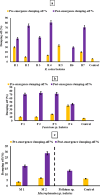


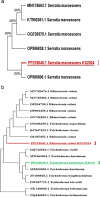


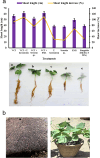
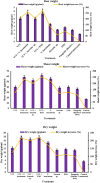
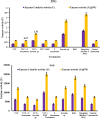
Similar articles
-
In-vitro compatibility assay of indigenous Trichoderma and Pseudomonas species and their antagonistic activities against black root rot disease (Fusarium solani) of faba bean (Vicia faba L.).BMC Microbiol. 2021 Apr 17;21(1):115. doi: 10.1186/s12866-021-02181-7. BMC Microbiol. 2021. PMID: 33865331 Free PMC article.
-
Integrated options for the management of black root rot of strawberry caused by Rhizoctonia solani Kuhn.C R Biol. 2015 Feb;338(2):112-20. doi: 10.1016/j.crvi.2014.11.006. Epub 2015 Jan 13. C R Biol. 2015. PMID: 25595298
-
Biocontrol efficacy of different isolates of Trichoderma against soil borne pathogen Rhizoctonia solani.Pol J Microbiol. 2014;63(1):95-103. Pol J Microbiol. 2014. PMID: 25033669
-
Tobacco leaf spot and root rot caused by Rhizoctonia solani Kühn.Mol Plant Pathol. 2011 Apr;12(3):209-16. doi: 10.1111/j.1364-3703.2010.00664.x. Epub 2010 Oct 1. Mol Plant Pathol. 2011. PMID: 21355993 Free PMC article. Review.
-
Harnessing Trichoderma Mycoparasitism as a Tool in the Management of Soil Dwelling Plant Pathogens.Microb Ecol. 2024 Dec 21;87(1):158. doi: 10.1007/s00248-024-02472-2. Microb Ecol. 2024. PMID: 39708106 Free PMC article. Review.
References
-
- Abera B, Berhane M, Nebiyu A, et al. Diversity, use and production of farmers’ varieties of common bean (Phaseolus vulgaris L., Fabaceae) in southwestern and northeastern Ethiopia. Genet Resour Crop Evol. 2020;67:339–356. doi: 10.1007/s10722-019-00877-4. - DOI
-
- Kebede E (2021) Contribution, utilization, and improvement of legumes-driven biological nitrogen fixation in agricultural systems. Front Sustain Food Syst 5:767998. 10.3389/fsufs.2021.767998
MeSH terms
Substances
Supplementary concepts
LinkOut - more resources
Full Text Sources
Miscellaneous

